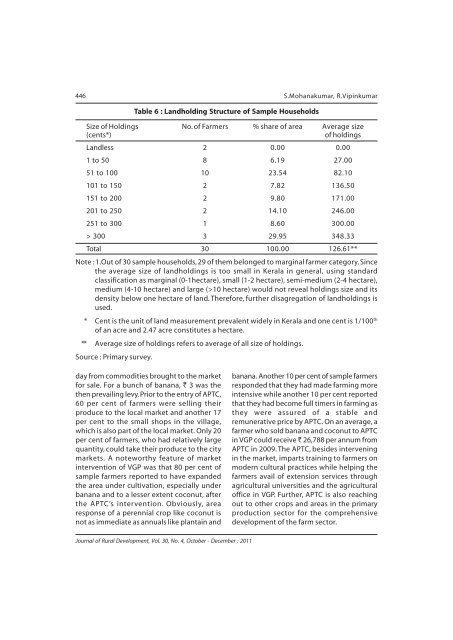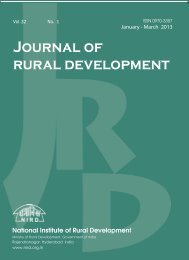Issue for October - December 2011 - National Institute of Rural ...
Issue for October - December 2011 - National Institute of Rural ...
Issue for October - December 2011 - National Institute of Rural ...
You also want an ePaper? Increase the reach of your titles
YUMPU automatically turns print PDFs into web optimized ePapers that Google loves.
446 S.Mohanakumar, R.VipinkumarTable 6 : Landholding Structure <strong>of</strong> Sample HouseholdsSize <strong>of</strong> Holdings No. <strong>of</strong> Farmers % share <strong>of</strong> area Average size(cents*)<strong>of</strong> holdingsLandless 2 0.00 0.001 to 50 8 6.19 27.0051 to 100 10 23.54 82.10101 to 150 2 7.82 136.50151 to 200 2 9.80 171.00201 to 250 2 14.10 246.00251 to 300 1 8.60 300.00> 300 3 29.95 348.33Total 30 100.00 126.61**Note : 1.Out <strong>of</strong> 30 sample households, 29 <strong>of</strong> them belonged to marginal farmer category. Sincethe average size <strong>of</strong> landholdings is too small in Kerala in general, using standardclassification as marginal (0-1hectare), small (1-2 hectare), semi-medium (2-4 hectare),medium (4-10 hectare) and large (>10 hectare) would not reveal holdings size and itsdensity below one hectare <strong>of</strong> land. There<strong>for</strong>e, further disagregation <strong>of</strong> landholdings isused.* Cent is the unit <strong>of</strong> land measurement prevalent widely in Kerala and one cent is 1/100 th<strong>of</strong> an acre and 2.47 acre constitutes a hectare.** Average size <strong>of</strong> holdings refers to average <strong>of</strong> all size <strong>of</strong> holdings.Source : Primary survey.day from commodities brought to the market<strong>for</strong> sale. For a bunch <strong>of</strong> banana, ` 3 was thethen prevailing levy. Prior to the entry <strong>of</strong> APTC,60 per cent <strong>of</strong> farmers were selling theirproduce to the local market and another 17per cent to the small shops in the village,which is also part <strong>of</strong> the local market. Only 20per cent <strong>of</strong> farmers, who had relatively largequantity, could take their produce to the citymarkets. A noteworthy feature <strong>of</strong> marketintervention <strong>of</strong> VGP was that 80 per cent <strong>of</strong>sample farmers reported to have expandedthe area under cultivation, especially underbanana and to a lesser extent coconut, afterthe APTC’s intervention. Obviously, arearesponse <strong>of</strong> a perennial crop like coconut isnot as immediate as annuals like plantain andbanana. Another 10 per cent <strong>of</strong> sample farmersresponded that they had made farming moreintensive while another 10 per cent reportedthat they had become full timers in farming asthey were assured <strong>of</strong> a stable andremunerative price by APTC. On an average, afarmer who sold banana and coconut to APTCin VGP could receive ` 26,788 per annum fromAPTC in 2009. The APTC, besides interveningin the market, imparts training to farmers onmodern cultural practices while helping thefarmers avail <strong>of</strong> extension services throughagricultural universities and the agricultural<strong>of</strong>fice in VGP. Further, APTC is also reachingout to other crops and areas in the primaryproduction sector <strong>for</strong> the comprehensivedevelopment <strong>of</strong> the farm sector.Journal <strong>of</strong> <strong>Rural</strong> Development, Vol. 30, No. 4, <strong>October</strong> - <strong>December</strong> : <strong>2011</strong>
















